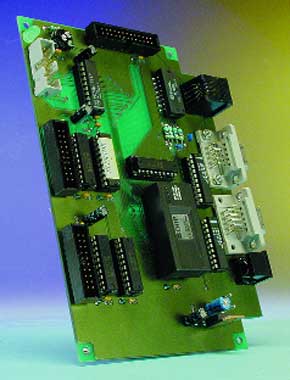Personal Mini Webserver (1)
a development board with an embedded PC

This is a MEMBER ONLY article. You need a subscription to read this article.
- Unlimited access to online Member Only articles
- 3 new editions Elektor Magazine (digital)
- More than 5000 Gerber files
- 20% member discount on e-books (at elektor.com)
- 10% member discount on Products (at elektor.com)
Available from €5.33 per month.
What is Members Only
Elektor is committed to providing high-quality content on electronics, catering to tens of thousands of paying members. As part of this commitment, Elektor has launched Premium, an initiative that offers exclusive online articles to members sometimes even before they appear in the magazine.
Every day, members can access in-depth articles that showcase the best of Elektor's premium content.
This initiative aims to reward members with early access. Once logged in, members can easily enjoy this exclusive content and engage in discussions about featured projects. While Premium adds to the existing resources available, Elektor will continue to provide a wealth of free information.
Join the Elektor community today to take advantage of Premium and other benefits!
Materials
Gerber file
CAM/CAD data for the PCB referred to in this article is available as a Gerber file. Elektor GREEN and GOLD members can exclusively download these files for free as part of their membership. Gerber files allow a PCB to be produced on an appropriate device available locally, or through an online PCB manufacturing service.
Elektor recommends the Elektor PCB Service service from its business partner Eurocircuits or AISLER as the best services for its own prototypes and volume production.
The use of our Gerber files is provided under a modified Creative Commons license. Creative Commons offers authors, scientists, educators and other creatives the freedom to handle their copyright in a more free way without losing their ownership.
Component list
R1,R2 =47Ohm
R3 =220Ohm
R4,R5 =4kOhm 7
P1 = 10kOhm preset
Capacitors:
C1 = 10nF
C3,C8.-C18 = 100nF
C4-C7 = 10µF 16V radial
C2 = 100µF 16V radial
Semiconductors:
D1 = LED, green
IC2 = 74HCT573
IC4,IC6 = 74HCT574
IC3 = GAL16V8 (programmed, order code 010036-31)
IC5,IC7 = 74HCT541
IC8 =7805
IC9,IC10 =MAX233CPP
IC1 = IPC@CHIP SC12 (order from Beck, http://www.bcl-online.de)
Miscellaneous:
PC1,PC2 = solder pins
TR1 = FS22-101Y4 (order from Beck, http://www.bcl-online.de)
K1 = 6-way Mini-DIN socket (female), pins at 240 degrees, PCB mount
K2 = RJ45 socket (female), PCB mount
K3,K4 = 9-way Sub-D plug (male), PCB mount, angled pins
K5 = 14-way boxheader or pinheader
K6,K7 = 20-way boxheader or pinheader
K8 = 26-way boxheader or pinheader
Enclosure:
PCB, order code 010036-1



Discussion (0 comments)